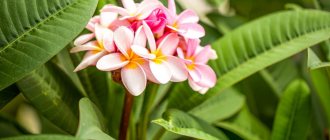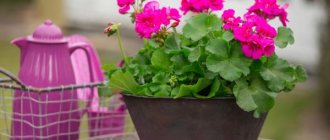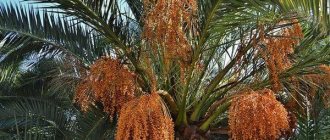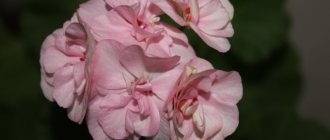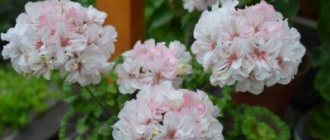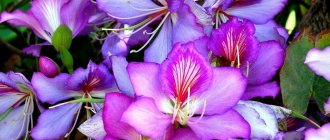It is convenient to propagate pelargonium by cuttings. This is the simplest and most effective method, which in 99% of cases allows you to get good results. However, if we are talking about rare varieties of geraniums, which are quite difficult to find on the shelves of florist shops, the best option would be the seed method of propagating geraniums. Today there are a sufficient number of seeds of excellent quality on sale, from which you can grow a rare plant species.
Seed requirements
In order for pelargonium seedlings to sprout and develop successfully, it is necessary to select high-quality planting material. The seeds should be brown, oblong in shape and always hard. Other options for seeding material can either produce low-quality seedlings, or even leave the grower without a “harvest.” To avoid such troubles, you should not buy seeds at the market or in supermarkets. For this purpose, it is better to visit a specialized store, the quality of the goods in which will be guaranteed to be high. Good seeds are sold ready for sowing, so you don’t have to do any complicated manipulations to get them to germinate.
Geranium seeds
Also, when choosing planting material, pay attention not only to the beauty, shape and richness of the shade of the buds, but also to the maintenance conditions that the flower will need to provide for healthy growth and full flowering. If creating the appropriate conditions necessary for growing the selected type of geranium from seeds at home seems too difficult to you, it is better to opt for another variety of pelargonium.
Botanical description of the plant
Geranium is a perennial herbaceous plant belonging to the Geraniaceae family of the same name. South America is considered to be the birthplace of this flower, so it is often used only as an indoor ornamental plant for interior landscaping. Today the family has about 300 representatives, so geraniums are often found not only in a variety of colors, but also in shape.
The plant consists of a herbaceous branched stem, so often an adult plant resembles a small ornamental bush. The average flower height is in the range of 40–60 cm. The root system of representatives of the fibrous type species is branched. At the end of large stems, small thickenings form, which store nutrients and water, thereby saving the bush from death during an unfavorable period.
Did you know? The worldwide popularity of geranium is thanks to the botanist and traveler Paul Krampel. In 1900, he began secretly propagating the flower and within two years created an entire plantation, the simultaneous flowering of which caused a real stir among the population of France, and later other countries.
Depending on the variety, the leaf structure may have various variations. The leaf blade can be either whole or heavily cut, with a curled edge. Each leaf is located on an elongated petiole. The color of the leaves can be varied, there are varieties with green, blue, gray and even red, and there are also varieties with all kinds of colored inclusions on the leaf and small fibers.
Geranium blooms from mid-April to the second half of August, but under optimal conditions, this phase can be extended until the second half of September. During this period, small peduncles with 2-3 flowers form on the plant. The flowers are often large, with 5 petals, and their colors vary. There are varieties with white, blue, purple, red shades and tones. After flowering, elongated fruit boxes are formed on the bush, similar in shape to the beak of a crane.
When to plant geraniums
There is no specific answer to this question. It all depends on the gardener’s desire and ability to provide the seedlings with the required amount of light. Geranium is not a particularly picky plant to grow.
Florists recommend sowing in spring or summer, when daylight hours approach their maximum. However, if you have special equipment with which you can provide the seedlings with the required amount of light, there will be no time restrictions for you. It will take 3-5 months for geraniums to grow to medium size.
Features of planting material
In appearance, the flower seeds resemble coffee beans. They are located in the seed box.
One of the sides is slightly convex, and the other is flat, with a pronounced dividing line. Color – rich brown. A small downy umbrella acts as a dense shell covering the seeds. After ripening, the capsule bursts and fruits appear in its place. When flowers appear on pelargonium, you should take care of the seeds. The option of artificial pollination is possible. You can transfer pollen using a needle or tweezers. In the very center of the plant there are 10 stamens and 1 pistil with stigma. It is necessary to carefully take pollen from one flower and transfer it to the stigma of another, which should have bloomed a few days before. Pollination using this method can be done many times.
Now about how to collect ripened seeds. After pollination has occurred, 4-5 days later, the column begins to grow. The capsule fruit is pointed and elongated. The fruit will burst immediately after the seeds ripen. Slightly oblong seeds, which are covered with light fibers, hang on thin and dense threads.
Harvesting takes place when the grains are completely ripe. Dry, opened boxes are considered evidence of maturity.
Attention! It is necessary to ensure that the seeds do not fall out or germinate, because in this case, storing them will be impossible.
We invite you to watch a video about the collection and features of planting material:
Preparing seeds for sowing
If you purchased high-quality seeds from a well-known company, you will not need to carry out complex preparatory procedures. All you need in this case is to store the planting material in a dry, dark place, protected from insects and sunlight.
If the packaging with seeds indicates that the material is not prepared for planting, or you have some doubts about the quality of preparation, additional processing will be required. To do this, use phytohormones (“Epinom”, “Zirconom”), after which the seedlings are soaked in warm water for several hours. Carrying out such procedures helps accelerate seed germination and improves the quality of seedlings.
The most problematic for gardeners are seeds grown and collected at home. This will require a maximum range of activities. First, the material is cleared of the coarse top layer, which can slow down the germination process. To do this, the seeds are sanded using sandpaper. After this, they are treated with phytohormones (“Epin”, “Zircon”) and soaked in warm water for several hours.
Important! When using seeds obtained at home, the likelihood of obtaining high-quality seedlings is extremely low. The reason for this state of affairs is the loss of the gene transmitted by the mother plant by hybrid varieties of pelargonium during seed propagation.
Transfer
Replanting pelargonium
If 2-3 leaves appear on the seedlings, get ready to replant them. Containers with a diameter of 10 cm are suitable for geraniums. Subsequently, repeated picking into larger containers will be required. Choose ceramic pots. Natural material protects plants from overheating and helps retain moisture. Rules for picking plants:
- Geranium is transplanted using the transshipment method, i.e. without disturbing the earthen coma and roots.
- When replanting, add long-acting fertilizers: do not choose fresh organic matter, give preference to synthetic mixtures rich in phosphate, nitrogen, potassium, boron, iron, magnesium, copper (special con, “Pelargonium” from Agrecol, Substral, Bopon).
- Lightly water the planted geraniums with warm water. If it's warm outside, place the pots on the balcony.
If you have a summer house, plant homemade geraniums in the garden bed. Suitable time for growing in open ground is May - September. Keep in mind that geraniums need to be replanted without buds. The composition of garden soil should be similar to the soil in a pot.
Preparing the soil and container
The seed material is dry, so it is sown in loose soil. Planting seeds in clay or too dense soil is unacceptable. The soil mixture can be purchased at a specialty store or you can prepare it yourself. To prepare the substrate, use the following proportions:
- peat, sand and turf soil are mixed in a ratio of 1:1:2;
- sand and peat are mixed in equal parts (1:1);
- peat and perlite are mixed in equal proportions (1:1).
The most acceptable is the first soil option.
Important! Choose quality ingredients when preparing the soil. Poor quality soil can spoil the seeds.
Sowing seeds is carried out both in separate containers and in a common pot. By choosing the first option, you are guaranteed to protect the root system of future seedlings from damage at the time of transplantation. The second option, in case of careful handling of seedlings, is also convenient and practical. The main thing is to plant the seeds at a distance of 5–7 cm from each other.
The container must be deep so that its volume is sufficient to accommodate the soil and for a complete drainage layer necessary to provide the roots with oxygen.
Planting pelargonium seedlings in flower beds and containers
First autumn sowing of geraniums
It so happened in the end that we only had two seedlings left from the first sowing. We could have saved more, but we didn't bother too much. These two seedlings were planted in small pots in March. They bloomed in July, but not very much. These plants are still blooming, but they have practically not increased in growth or beauty.
1 photo taken on March 9 - transplanting into pots, 2 photos - June 7, 3 photos - July 18 - first flowering of pelargonium variety Apple Blossom
Second and third sowings of pelargonium
On the second May holidays, young geraniums were planted at the dacha: some got a flower garden, some got beautiful pots, and some got an old red bucket that no one needed). There were a lot of seedlings and space was also required.
Caring for them was simple: when planting, complex mineral fertilizer was added to the holes and it was added during the summer. Watering as needed, fertilizing as we remember... And in July we have a lot of blooming geraniums of all colors and shades. This geranium is still blooming to this day, even while the one that has not yet been taken from the dacha. Autumn is warm...
Decoration of the site with pelargoniums from Olga Petina and Yuri Petina), August 22
How to plant geranium seeds
Sowing geranium seeds is no different from other plants. The pot is filled with drainage, and then with soil, the seeds are laid out and covered with sand or soil.
Important! The seeds should be at a depth of no more than 3–4 cm. Otherwise, their germination will take too long.
After filling the seeds, we moisten the soil with a spray bottle, cover the container with film or glass, place the pot in a well-lit place and wait for the result. Growing pelargonium with seeds requires a room temperature of +23 °C. Lower rates may stop the germination of seedlings.
The most popular varieties with photos
The most popular types of pelargonium are zonal, ivy-leaved and fragrant. The plants are not particularly demanding on the composition of the soil, grow quickly, are unpretentious in fertilizing and are characterized by a long flowering period. Each species has the most popular varieties, which are presented in the photo below.
The Early Universal variety is the most common among amateur flower growers. The period from planting seeds to flowering is more than 2 months
Zonal species of pelargonium propagate well both by seeds and cuttings. They can be grown in containers, flower pots, and flowerpots. They are recommended for open and closed ground. The colors of the buds are rich and varied.
Colorama belongs to the zonal species of pelargonium. The bushes are low, with large flowers. The leaves have a characteristic dark horseshoe-shaped pattern.
It is preferable to grow colorama in pots, since with a compact root system, the green ground part is very fluffy and voluminous. In summer, it can be planted in open ground.
The variety Summer Rain belongs to the group of ivy-leaved or ampelous
Thin but strong shoots of pelargonium Summer Rain fall up to 100 cm. The leaves are smooth, dark green, and flowering is abundant. There are different shades. Indispensable for decorating balconies, gazebos, terraces.
The leaves of the Black Velvet variety differ from other varieties in their chocolate, almost black color. The inflorescences are bright, velvety
Young shoots and leaves are always light green, but after a few weeks they begin to darken. Most of the flowers on sale are red in color.
The Cabaret variety can be identified by its lush green leaves with wavy, ribbed edges. It does not exceed 30 cm in height. The yellow core is clearly visible at the base of each flower.
Pelargonium Cabaret has spherical flowers 10–12 cm in size. It is susceptible to direct sunlight and does not tolerate dry soil. It comes in colors from dark burgundy to snow-white.
The Orange Ice variety is characterized by a juicy red-orange color of the inflorescences and a pale yellow-green tint of foliage
During the flowering period, the Orange Ice bush reaches up to 35 cm in diameter. Suitable for both indoor and outdoor decor. It is unpretentious, grows quickly, and differs from other types in its early flowering.
The Violet Chandelier is a unique look with rich purple or blue buds
The Chandelier Violet variety is distinguished not only by its abundant, but also long flowering - from May to October. The leaves are small, with pointed edges, almost invisible under the buds.
Victoria is a tulip-shaped pelargonium variety from the latest series of selection. Popular due to the unusual structure of the buds
All tulip-shaped types of pelargonium are characterized by small but numerous inflorescences (up to 50 pieces), located on tall, strong stems. They grow up to 70 cm in height. They are easy to propagate, have a pronounced aroma, and bloom for 3–4 months in a row.
Is it worth planting pelargonium seeds by ordering them from Aliexpress?
Most customer reviews about purchasing pelargonium seeds from Aliexpress are negative. Only a few confirm that the seeds really germinate well and the flower grows as stated in the description on the pack.
More than 80% of sellers send seeds of the wrong variety or of poor quality with almost zero germination. Therefore, to prevent such risks, it is still worth abandoning Chinese seeds and spending a little more money on a quality product from a domestic manufacturer.
Care for sowing and seedlings
Be sure to lift the film once a day, providing the seedlings with an influx of oxygen. If everything is done correctly, the first shoots will appear within 4 weeks .
If you create the right conditions, the new “generation” of seedlings grows quickly enough and does not cause much trouble. But do not forget that young individuals are too fragile. Therefore, it is necessary to protect new seedlings from drafts, strong winds that can break fragile stems, and exposure to sunlight (obligatory shading of seedlings placed on a southern windowsill is necessary).
Growing geraniums from seeds at home requires providing the seedlings with a sufficient amount of moisture. To avoid flooding the seedlings, daily watering with measured application of moisture is recommended (a regular pipette can be used as a dispenser). In winter, watering should be more moderate than in summer.
If water gets on the stems during watering, black spots may appear on the skin of the young plant. They can be eliminated by watering the seedling with a solution of potassium permanganate or phytoalcohol.
Important! After the seedlings emerge, the temperature must be lowered to +20…+16 °C. If the seedlings become too cold, it will be impossible to save the young individuals.
The first large leaf of seedlings is usually released 1–2 weeks after germination. The intensity of subsequent growth will depend on temperature conditions, soil quality and irrigation intensity.
Reproduction methods
There are only two main methods: seed and vegetative (using cuttings, dividing the bush). Pelargonium hybrids that were grown from their own seeds do not have the properties of the parent. In order to preserve the necessary characteristics, they are propagated exclusively by vegetation.
Experienced flower growers are interested in growing this or that variety of pelargonium from seeds on their own. You can use store-bought or your own grains. A flower grown from seeds blooms more abundantly and longer than one grown from a cutting.

